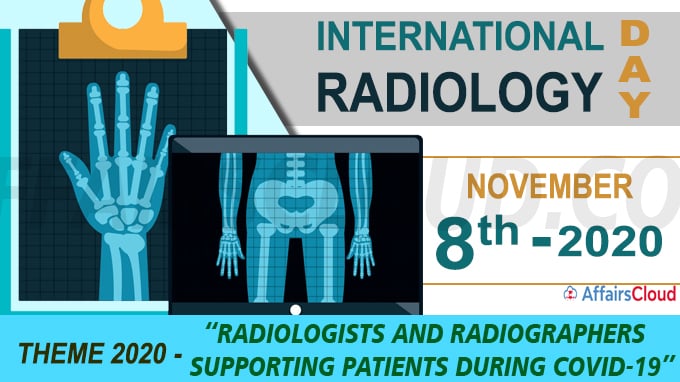 The International Day of Radiology(IDoR) is annually celebrated by radiologists, radiographers, radiological technologists and professionals across the globe on 8th November. The day is celebrated to create awareness on the importance and value of the contribution of Radiology in the safe patient care. The day was first launched in 2012.
The International Day of Radiology(IDoR) is annually celebrated by radiologists, radiographers, radiological technologists and professionals across the globe on 8th November. The day is celebrated to create awareness on the importance and value of the contribution of Radiology in the safe patient care. The day was first launched in 2012.
The 8th November 2020 marks the 8th International Day of Radiology.
The theme of 2020 IDoR is “Radiologists and radiographers supporting patients during COVID-19”.
Aim of the Day:
To recognise the innovations in radiology research that have revolutionised modern medicine.
Background:
i.The International Day of Radiology was a joint initiative of the European Society of Radiology (ESR), the Radiological Society of North America (RSNA) and the American College of Radiology (ACR) with the involvement of the International Society of Radiology (ISR).
ii.The other supporting organisation include,
- Asian Oceanian Society of Radiology (AOSR)
- The Colegio Interamericano de Radiología (CIR)
- The Royal Australian and New Zealand College of Radiologists (RANZCR)
- The Radiological Society of South Africa (RSSA – which also represents neighbouring countries)
- The European Federation of Radiographer Societies (EFRS)
- The International Society of Radiographers & Radiological Technologists (ISRRT).
iii.The 8th November was chosen as IDoR to mark the discovery of the existence of X-Rays by Wilhelm Conrad Röntgen on 8th November 1895.
Events of IDoR 2020:
Various public lectures and other activities will be organised by the National radiological societies, radiological subspecialty societies, radiographers’ societies and allied sciences societies across the globe.
Radiology:
i.Radiology is a branch of medicine which uses medical imaging to diagnose and treat the diseases inside the body of animals and humans.
ii.The radiology procedures include X-rays, computed tomography (CT), magnetic resonance imaging (MRI), nuclear medicine, positron emission tomography (PET) and ultrasound.
iii.Radiology is divided into two areas, diagnostic radiology and interventional radiology.
Diagnostic Radiology:
i.The diagnostic radiology referred to the use of non-invasive imaging scans to diagnose a patient.
ii.This method involves low amounts of radiation to create a detailed image of an area.
iii.Radiography (X-rays) is an example of Diagnostic Radiology.
Interventional Radiology:
i.The interventional radiology involves a range of imaging procedures to get an image of the inside of the body.
ii.X-ray fluoroscopy, CT, MRI are examples of interventional radiology.




